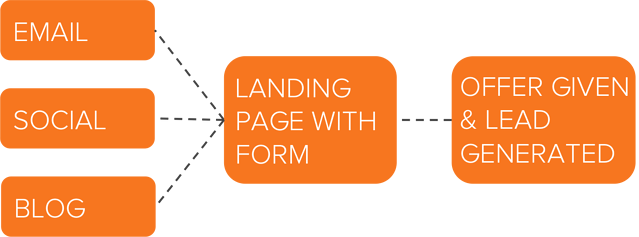Generating leads with inbound marketing
Finding new potential customers: it’s what we all want, right? Inbound marketing makes it painless – no awkward phone calls to strangers and no having to put in a lot of effort for people who turn out not to be interested or who are not in your target group.
Inbound marketing and lead generation
Before we look more deeply at the methods and forms of lead generation with inbound marketing, let’s take two small steps back: What is inbound marketing and what is lead generation?
Inbound marketing: an introduction
Put briefly, inbound marketing means attracting customers to you. You don’t chase after your potential customers, but let them come to you when they need you. No phone calls to strangers, but striking content such as blogs, e-books and white papers. As soon as your prospect starts looking for information, they come across your content and get to know your company. This creates a bond between the (potential) customer and the brand without making any imposition. Read more about what inbound marketing is in our blog!
What is lead generation?
Lead generation is the process of attracting strangers and prospects and converting them into leads. A lead is someone who has shown an interest in your product or service and potentially becomes a customer.
Generating leads according to the inbound method
Now that you understand the inbound method and lead generation, you can probably already see how these will work together. Attracting potential customers or leads. The lead generation process consists of two steps: attract and convert. You want to attract new people: attract and interact to collect their data: convert.
In the inbound marketing diagram below, we go from strangers (grey) to leads (orange).

Attract
To collect new leads, you first need to reach new people. Always keep your buyer persona in mind. Ask yourself the question: Who do I want to reach and where can I find them? I will explain the various ways to reach your target group later.
Convert
Now that your target group has found you, you will also want to know who they are. Once you have a name, email address, phone number or company name, you can follow up with relevant content and eventually convert them into customers.
To collect the data, you use a “content offer”. This is a piece of valuable information in exchange for which people are willing to give their data. This could be a checklist, e-book or discount coupon that they can get by leaving their email address.
Ways of generating inbound leads
This is all well and good, but how do you reach those people? As promised, here are 4 ways to reach new people.

With email, you are not exactly reaching new people: if you have their email address, they are already known to you. Still, it is a good channel for reaching people who have not yet become customers. It is much easier to ask them to take action because they already know you. Use an eye-catching subject line to attract attention and a clear button in the email to get them to take action.
Social media
There are two sides to social media: organic – unpaid content (more on that in this blog) and paid social – paid content and ads. Both sides can reach new people.
The advantage of paid posts on social media is that you can configure exactly who should see your content. In this way, you can be sure that you only pay for a relevant target group. Again, make sure there is a clear follow-up action. If you want people to convert, the destination page and offer must match exactly what was promised in the ad, and the action you want users to take must be crystal clear.
Blogging
The beauty of using your blog posts to promote an offer is that you can adapt the entire blog to the end goal. So, if your offer is an instructional video on creating an inbound campaign, your blog post could be about what inbound is, and its benefits. This makes your offer highly relevant and easy to click through to.
Search Engine Optimization
This one is not in the diagram above, but I wanted to mention it anyway. I believe that SEO is a must to attract new leads.
With SEO, you ensure that your website is easily found in search engines such as Google. Suppose you have a bike rental business in Rotterdam, and someone searches for 'rent a bike in Rotterdam' – you want to be listed at the top, of course. There are many methods to achieve this.
Do you want to get started with your SEO? In this blog, we tell you more about it, and we explain exactly how blogging helps SEO.
You may also like

Inbound marketing: what is it?

Why do you need to get started with Account-Based Marketing (ABM)?




